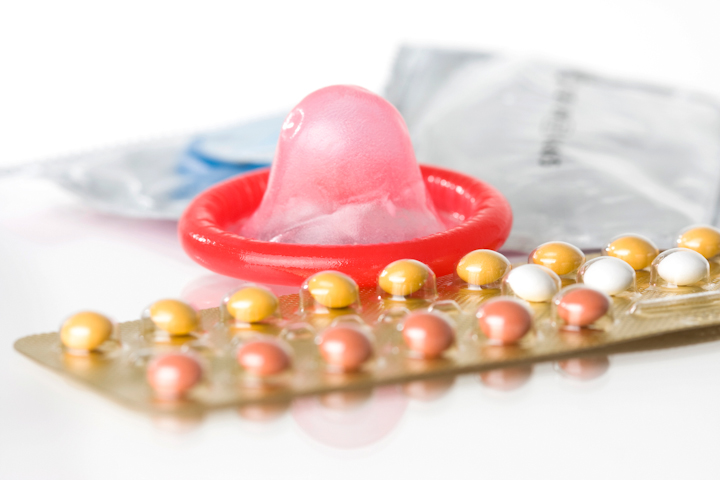Contraception is not one-size-fits-all.
The ideal solution for each person or each couple would depend on age, health, frequency of sexual activity, future plans to have children, and family history of certain diseases. Talk to your doctor to discuss the best method for you.
Contraception can be divided into:
- Barrier methods
- Hormonal methods
- Intrauterine methods
All forms of contraception carry some form of risk.
An important consideration is the effectiveness rate, which is measured by the Pearl Index, the most common technique used in clinical trials for reporting the effectiveness of a birth control method. Long-acting reversible methods of contraception are preferred by many doctors due to the low risk of user failure.
Here are the basics you need to know about some forms of contraception.
Barrier Methods
Designed to prevent sperm from entering the uterus, barrier methods are removable and may be an option for women who cannot use hormonal methods of contraception. These include:
Male condoms
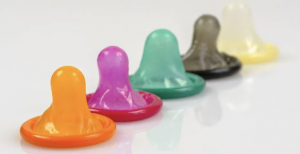 Made of latex or polyurethane, this is a thin sheath that covers the penis to collect sperm and prevent it from entering the woman’s body. When used consistently and correctly during vaginal, oral, or anal intercourse, condoms are highly effective in preventing the sexual transmission of sexually transmitted diseases (STDs) or sexually transmitted infections (STIs) such as gonorrhea, chlamydia, and trichomoniasis, genital herpes, syphilis, chancroid, and human papillomavirus (HPV).
Made of latex or polyurethane, this is a thin sheath that covers the penis to collect sperm and prevent it from entering the woman’s body. When used consistently and correctly during vaginal, oral, or anal intercourse, condoms are highly effective in preventing the sexual transmission of sexually transmitted diseases (STDs) or sexually transmitted infections (STIs) such as gonorrhea, chlamydia, and trichomoniasis, genital herpes, syphilis, chancroid, and human papillomavirus (HPV).
Usage tips:
- Use a water based lubricant such as Astroglide or KY Jelly to decrease the chance of the condom breaking. Do not use oil-based lubricants such as Vaseline of sun tan oil.
- To decrease the chance of the condom slipping down the penis or falling off inside the vagina, pull the penis out of the vagina right after ejaculation.
- Hold the rim of the condom onto the shaft of the penis during withdrawal.
- Never use more than one condom at a time.
- Never re-use a condom.
- When putting the condom on the penis you must avoid tearing the condom or putting a hole in it with fingernails, a ring, or anything sharp.
- Be sure to check the expiry date on the box.
- Use before any genital contact, as a man’s pre-cum contains some sperm.
Female condoms
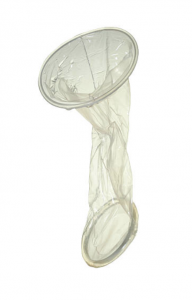 These are thin, flexible plastic pouches inserted deep into the vagina just before intercourse. The ring at the closed end holds the pouch in the vagina. The ring at the open end stays outside the vaginal opening during intercourse. The benefits and disadvantages of the female condom are similar to that of the male condom.
These are thin, flexible plastic pouches inserted deep into the vagina just before intercourse. The ring at the closed end holds the pouch in the vagina. The ring at the open end stays outside the vaginal opening during intercourse. The benefits and disadvantages of the female condom are similar to that of the male condom.
Usage tips:
- Inserting: Put spermicide or lubricant on the outside of the closed end. Find a comfortable position. You can stand with one foot on a chair, sit on the edge of a chair, lie down, or squat. Squeeze together the sides of the inner ring at the closed end of the condom and insert it into the vagina like a tampon. Push the inner ring into the vagina as far as it can go — until it reaches the cervix. Pull out your finger and let the outer ring hang about an inch outside the vagina.
- Removing: Squeeze and twist the outer ring to keep semen inside the pouch. Gently pull it out of the vagina. Throw it away. Do not flush it down the toilet.
- Do not reuse the female condom.
Diaphragms
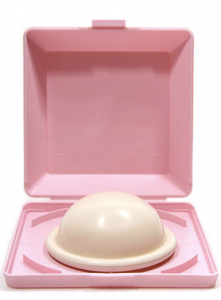 A diaphragm is a shallow, flexible cup made of latex or soft rubber that is inserted into the vagina before intercourse, blocking sperm from entering the uterus. Spermicidal cream or jelly should be used with a diaphragm. The diaphragm should remain in place for 6 to 8 hours after intercourse to prevent pregnancy, but it should be removed within 24 hours. Traditional latex diaphragms must be the correct size to work properly, and a health care provider can determine the proper fit.
A diaphragm is a shallow, flexible cup made of latex or soft rubber that is inserted into the vagina before intercourse, blocking sperm from entering the uterus. Spermicidal cream or jelly should be used with a diaphragm. The diaphragm should remain in place for 6 to 8 hours after intercourse to prevent pregnancy, but it should be removed within 24 hours. Traditional latex diaphragms must be the correct size to work properly, and a health care provider can determine the proper fit.
Usage tips:
- A diaphragm should be replaced after 1 or 2 years.
- Women also need to be measured again for a diaphragm after giving birth, having pelvic surgery, or gaining or losing more than 15 pounds.
Cervical caps
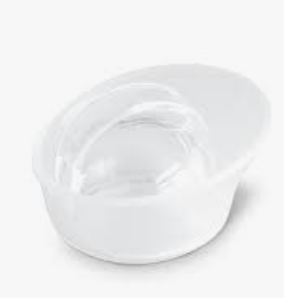 These are similar to diaphragms, but smaller, more rigid, and less noticeable. The cervical cap is a thin silicone cup that is inserted into the vagina before intercourse to block sperm from entering the uterus. As with a diaphragm, the cervical cap should be used with spermicidal cream or jelly. The cap must remain in place for 6 to 8 hours after intercourse to prevent pregnancy, but it should be removed within 48 hours.
These are similar to diaphragms, but smaller, more rigid, and less noticeable. The cervical cap is a thin silicone cup that is inserted into the vagina before intercourse to block sperm from entering the uterus. As with a diaphragm, the cervical cap should be used with spermicidal cream or jelly. The cap must remain in place for 6 to 8 hours after intercourse to prevent pregnancy, but it should be removed within 48 hours.
Usage tips:
- Cervical caps come in different sizes. A doctor “fits” a woman for a cervical cap.
- May be put in up to one hour before sex.
- It will work continuously for 48 hours.
- It does not matter how many times a couple has sex as long as you leave it in at least six to eight hours after the last time you have sex.
- You must wash your hands with soap and water before putting in the cap.
- If left in too long, increases slightly a woman’s risk for a very serious infection called toxic shock syndrome. Don’t leave your cervical cap in for more than 48 hours.
- New fitting may be necessary after a baby, abortion, miscarriage, or gaining 15 pounds.
- It is not recommended that you use a cervical cap during menstruation.
Hormonal Methods
Hormonal methods of birth control use hormones to regulate or stop ovulation and prevent pregnancy. Ovulation is the biological process in which the ovary releases an egg, making it available for fertilisation. Hormones can be introduced into the body through various methods, including pills, injections, skin patches, transdermal gels, vaginal rings, intrauterine systems, and implantable rods. Depending on the types of hormones that are used, these pills can prevent ovulation; thicken cervical mucus, which helps block sperm from reaching the egg; or thin the lining of the uterus.
Combined oral contraceptives (“the pill”)
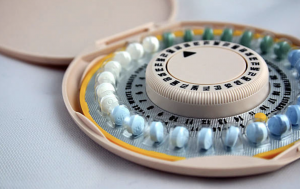 Combined oral contraceptive pills contain different combinations of the synthetic oestrogen and progesterone. They work by stopping ovulation (release of an egg) and by inhibiting the movement of sperm. Use of pills is not recommended for women over the age of 35 who smoke tobacco, have high blood pressure, a history of blood clots, or a history of breast, liver, or endometrial cancer. While pills do have serious side effects, they can also significantly decrease a woman’s menstrual cramps and pain, reduce menstrual blood loss and anemia, and reduce prevalence of acne by up to two-thirds. They also protect against ovarian cancer.
Combined oral contraceptive pills contain different combinations of the synthetic oestrogen and progesterone. They work by stopping ovulation (release of an egg) and by inhibiting the movement of sperm. Use of pills is not recommended for women over the age of 35 who smoke tobacco, have high blood pressure, a history of blood clots, or a history of breast, liver, or endometrial cancer. While pills do have serious side effects, they can also significantly decrease a woman’s menstrual cramps and pain, reduce menstrual blood loss and anemia, and reduce prevalence of acne by up to two-thirds. They also protect against ovarian cancer.
Usage tips:
- Take the pill at the same time each day. Set an alarm to remember your pill.
- Pills alone do not protect against STIs and HIV. For increased protection against sexually transmitted diseases, use condoms as well.
Progesterone-only pills
Progesterone-only pills or minipills thicken cervical mucus, making it difficult for sperm to swim into the uterus or to enter the fallopian tube. Minipills do not have oestrogen related side effects and can be taken by women who have had side effects or complications using oestrogen-containing pills. The amount of the progesterone in minipills is less than in combined pills. They alter the normal cyclical changes in the uterine lining and may result in unscheduled or breakthrough bleeding. Like the combined pill, the minipill also has serious side effects; however they can also significantly decrease a woman’s menstrual cramps and pain, and reduce menstrual blood loss and anemia. They can cause irregular bleeding and may also stop bleeding altogether. Newer ones such as Cerazette ® can also prevent ovulation altogether, and is more effective than the older minipills (not available in Trinidad and Tobago).
Usage tips:
- A woman must remember to take a pill every single day.
- Some women using minipills gain weight or complain of feeling bloated. Regular exercise and attention to a nutritious diet can minimize or control weight gain.
- Pills alone do not protect against STIs and HIV. For increased protection against sexually transmitted diseases, use condoms as well.
Contraceptive patch
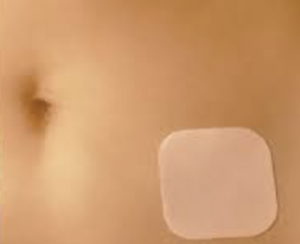 This is a thin, plastic patch that sticks to the skin and releases hormones through the skin into the bloodstream. The patch is placed on the lower abdomen, buttocks, outer arm, or upper body. A new patch is applied once a week for 3 weeks, and no patch is used on the fourth week to enable menstruation. Like other methods of birth control, the birth control patch releases the hormones oestrogen and progesterone. These work by keeping eggs from leaving the ovaries, and by making cervical mucus thicker to keep sperm from getting to the eggs. Side effects and benefits are similar to the contraceptive pill. The patch is a good option for women who have problems swallowing pills or remembering to take a pill every day.
This is a thin, plastic patch that sticks to the skin and releases hormones through the skin into the bloodstream. The patch is placed on the lower abdomen, buttocks, outer arm, or upper body. A new patch is applied once a week for 3 weeks, and no patch is used on the fourth week to enable menstruation. Like other methods of birth control, the birth control patch releases the hormones oestrogen and progesterone. These work by keeping eggs from leaving the ovaries, and by making cervical mucus thicker to keep sperm from getting to the eggs. Side effects and benefits are similar to the contraceptive pill. The patch is a good option for women who have problems swallowing pills or remembering to take a pill every day.
Usage tips:
- Store your unused, sealed patches at room temperature and out of direct sunlight.
- Consider the first day you apply the patch as “patch change day.” So if you first apply the patch on a Tuesday, you will always apply, change, or remove it on a Tuesday.
- Apply the sticky half of the patch to a clean and dry area of skin on your buttocks, stomach, upper outer arm, or back. Never put it on your breasts.
- Do not use body lotion, oil, powder, or makeup on skin where you are going to put the patch. They could keep the patch from sticking.
- Make sure to read the instructions on the box carefully so that you will know what to do if your patch becomes loose or if you forget to change it on time. This is important, as the week of the cycle that this occurs will differentiate what you need to do.
Injectable birth control
 This method involves injection of a progesterone, Depo-Provera® (DMPA—depo medroxyprogesterone acetate), given in the arm or buttocks once every 3 months. As with the patch, the injection releases the hormone progesterone, and works by keeping eggs from leaving the ovaries, and by making cervical mucus thicker to keep sperm from getting to the eggs.
This method involves injection of a progesterone, Depo-Provera® (DMPA—depo medroxyprogesterone acetate), given in the arm or buttocks once every 3 months. As with the patch, the injection releases the hormone progesterone, and works by keeping eggs from leaving the ovaries, and by making cervical mucus thicker to keep sperm from getting to the eggs.
There is a theoretical risk of thinning of the bones. Also, with this method, there can be a delay in return to fertility of up to a year.
Usage tips:
- If you are more than two weeks late for your injection, you may need a pregnancy test before getting your shot.
Vaginal rings
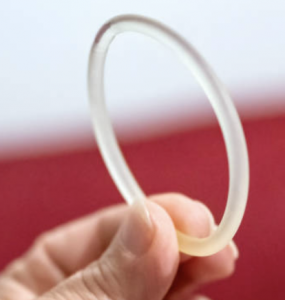 The ring is thin, flexible, and approximately 2 inches in diameter. It delivers a combination of a synthetic oestrogen (ethinyl estradiol) and a progesterone. The ring is inserted into the vagina, where it continually releases hormones for 3 weeks. The woman removes it for the fourth week and reinserts a new ring 7 days later. Risks for this method of contraception are similar to those for the combined oral contraceptive pills, and a vaginal ring is not recommended for any woman with a history of blot clots, stroke, or heart attack, or with certain types of cancer.
The ring is thin, flexible, and approximately 2 inches in diameter. It delivers a combination of a synthetic oestrogen (ethinyl estradiol) and a progesterone. The ring is inserted into the vagina, where it continually releases hormones for 3 weeks. The woman removes it for the fourth week and reinserts a new ring 7 days later. Risks for this method of contraception are similar to those for the combined oral contraceptive pills, and a vaginal ring is not recommended for any woman with a history of blot clots, stroke, or heart attack, or with certain types of cancer.
Usage tips:
- Store your unused rings at room temperature and out of direct sunlight.
- Check the expiration date of each ring package before insertion.
- Inserting: Wash your hands with soap and water. Use your fingers to press the sides of the ring together. Gently push the ring into your vagina. The exact position of the ring doesn’t matter.
- Removing: Remove it in three weeks on the same day of the week that it was inserted. Hook your finger under the forward rim and gently pull it out of the vagina.
- After one week without the ring, insert a new one — on the same day of the week that the previous one was inserted in your last cycle. During the one-week break, you will usually have your period. You may still be bleeding when it is time to insert a new ring. This is normal, too. But the vaginal ring must be inserted on the same day of the week as it was inserted in the last cycle, or you could get pregnant.
Implantable rods
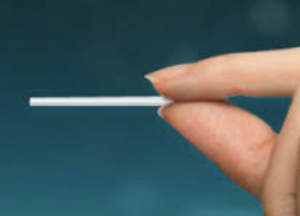 Each rod is matchstick-sized, flexible, and plastic. A physician surgically inserts the rod under the skin of the woman’s upper arm. The rods release a progesterone and can remain implanted for up to 3 years. After a woman is given a local anesthetic, insertion takes only a few minutes. Usually it does not hurt. Implants give off very small amounts of a hormone much like the progesterone a woman’s body produces during the last two weeks of each monthly cycle.
Each rod is matchstick-sized, flexible, and plastic. A physician surgically inserts the rod under the skin of the woman’s upper arm. The rods release a progesterone and can remain implanted for up to 3 years. After a woman is given a local anesthetic, insertion takes only a few minutes. Usually it does not hurt. Implants give off very small amounts of a hormone much like the progesterone a woman’s body produces during the last two weeks of each monthly cycle.
Usage tips:
- Implants do not protect from HIV/AIDS or other STIs. Use a condom, if you or your partner may be at risk.
Intrauterine Methods
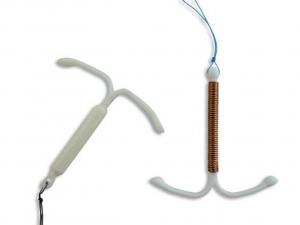 An IUD is a small, T-shaped device that is inserted into the uterus to prevent pregnancy. A health care provider inserts the device. An IUD can remain and function effectively for many years at a time. After the recommended length of time, or when the woman no longer needs or desires contraception, a health care provider removes or replaces the device.
An IUD is a small, T-shaped device that is inserted into the uterus to prevent pregnancy. A health care provider inserts the device. An IUD can remain and function effectively for many years at a time. After the recommended length of time, or when the woman no longer needs or desires contraception, a health care provider removes or replaces the device.
The risk of pregnancy while using an IUD is very low. However, if the IUD slips out of place, pregnancy can happen.
Copper IUDs
A copper IUD is spermicidal, and causes an inflammatory reaction that generally prevents sperm from reaching and fertilising the egg. If fertilisation of the egg does occur, the physical presence of the device prevents the fertilised egg from implanting into the lining of the uterus.
Hormonal IUDs
The released progesterone hormone causes thickening of the cervical mucus, inhibits sperm from reaching or fertilising the egg, thins the uterine lining, and also may prevent the ovaries from releasing eggs. Hormonal IUDs can be used for up to 5 years.
Usage tips:
- Never try to remove an IUD yourself. Visit a healthcare professional.
- Women using an IUD should have regular checkups to make sure everything is all right.
- If an IUD is going to slip out of place, it will most likely happen in the first few months of use. But it may occur later. The IUD is most likely to slip out of place during your period. Check your pads, tampons, or cups to see if the IUD has fallen out. If it has, you must check with your health care provider. Until then, use another form of birth control such as condoms.
- Between your periods, you can check for the string ends if you want to, but do not pull on them. Pulling the strings might make the IUD move out of place or even come out.
Adapted for WellnessConnect from Sources:
www.nichd.nih.gov
www.plannedparenthood.org

